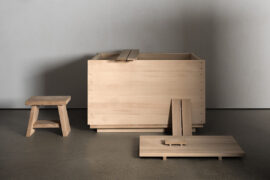A specialist in senior living, Dr YE Ng of Architectus Conrad Gargett draws on research into the ‘Blue Zones’ – regions worldwide where people have the longest lifespans – to offer insights into the key ingredients to create places for ageing well.

Harbord Diggers, photography by Brett Boardman.
November 24th, 2023
According to Dr YE Ng, associate principal and senior living lead at Architectus Conrad Gargett, Australia’s ageing population is on an unprecedented growth trajectory, with the government’s 2023 Intergenerational Report indicating a staggering threefold increase in people aged over 85, in the next four decades.
We might be living longer, but are we leading fuller, healthier lives in the later years? The built environment plays a pivotal role in influencing our health and lifestyles and shaping the quality and length of our lives. Here, Dr Ng draws on research into the ‘Blue Zones’ – regions identified throughout the world where people have the longest lifespans – and offers insight into the key ingredients we need to create places for ageing well.

Indesignlive: What are the big issues for conventional models in residential aged care and retirement living?
Dr YE Ng: The main issues include a lack of diversity, a disconnect from community and a sense of isolation – all factors that we know are not conducive to ageing well.
The traditional aged care model tends to have a one-size-fits-all approach that leads to limited choices and diversity. Person-centred care, with services tailored to the specific needs of each resident, is becoming increasingly important. But it’s often challenging to achieve in institutional settings. The concept of a safe and secure environment also inevitably creates a barrier between the surrounding community.
Retirement living models offer more diversity such as build-to-lease, build-to-rent, and assisted/supported living. But they often lack a connection to mixed-use, transport-orientated developments. These environments are key to creating a vibrant community. They provide easy access to public transport, shops, dining and recreational opportunities, which all support social interaction, mental stimulation and physical activity – vital ingredients for wellbeing.
Related: Why connectivity, amenity and access to nature are critical to liveability

What can the Blue Zones teach us about living longer and living well?
I was fortunate to meet Associate Professor Leigh Wilson at the 2022 AAG conference, who has studied ageing well and the contributing factors to longevity in the Blue Zones. The recently released Netflix documentary, Live to 100: Secrets of the Blue Zones, also examines these regions, offering insight into the principles behind living and ageing well.
Family, social interaction, exercise, a sense of purpose (Ikigai in Japanese), and a connection to nature have been identified as key elements people within the Blue Zones prioritise. These environmental and psychosocial factors in turn play an integral role in promoting active, healthy, productive and dignified ageing.
Good design and well-considered urban environments can promote and support active and healthy living, ensuring better health outcomes and overall wellbeing.

How can the design industry support better ageing?
Architects and urban planners can significantly shape the built environment to support the fundamental principles of living and ageing well. As the global population continues to age, creating age-friendly communities is essential.
Mixed-use developments are an excellent approach to creating active, social communities, including by providing easy access to essential services such as grocery stores and medical facilities. These developments can include a mix of typologies such as childcare, aged care, housing and commercial and recreational spaces, bringing together a diverse mix of people and age groups.

Harbord Diggers at Freshwater in Sydney is a great example of this. The design (by Architectus, CHROFI and JMD) has transformed a dated, single demographic club into a more connected intergenerational community hub. The project has significantly expanded the existing club’s offer with seniors’ apartments, retail, carparking, health and wellness, childcare, sporting and fitness facilities, and a food and beverage precinct. The site is structured around a central courtyard, an ocean terrace and a grid of public domain connections linking to the coast and nearby Freshwater.
The design conceals much of the program within the contour of the land to control visual impact with the seniors’ living village organised around the courtyard, and the club and associated public facilities located beneath. The outcome is a diverse set of facilities nestled gently into one of Sydney’s great coastal headlands and cleverly arranged to promote a healthy, social lifestyle – a place where seniors can expect to live a longer, healthier life.
Related: Psychology of design with novelist Amanda Lohrey

Rendu Towers for Ozcare, a new mixed-use development in Brisbane’s Newstead, is another excellent example of a mixed-use development in a vertical typology. The development includes two towers with a mix of residential aged care and independent, retirement living apartments. The towers are linked together by landscaped recreation zones with walking loops, fitness facilities and fantastic outdoor areas for socialising and interacting with family. The development also incorporates commercial tenancies and a cafe along with open green space accessible to the broader public, creating a vibrant, community-centred precinct.
Internationally, Hong Kong and Singapore are two well-known high-density cities with comparable features in their urban density, as a result integrated vertical typology, combining parks, open space planning, landscape design, community integration, health amenities and support services. The result is creative land use, resulting in not only higher efficiency, but also a new and unique living experience – a mini city of supportive network of services.

How should aged care and senior living look in the decades ahead?
The future of aged care and senior living should be shaped by a holistic approach that considers the evolving needs and preferences of individuals as they age in place. Over the coming decades, urban settings and design environments should be inclusive and responsive to the community’s physical, mental and emotional needs.
The built environment should allow seniors to age in place comfortably. Homes need to be adaptable and to incorporate universal design features that support independent living while meeting evolving needs. The setting should cater to diverse cultural, gender and lifestyle backgrounds. Spaces should be welcoming and culturally sensitive to create an environment where all residents feel at home, and the architecture should be geared towards enhancing residents’ quality of life. This includes creating spaces for social interaction, physical activity, cultural engagement and opportunities for lifelong learning.

The built environment should prioritise sustainability and environmental consciousness, minimising environmental impacts, using renewable resources and integrating green spaces for residents and communities to enjoy.
Community-based care models and childcare should be accessible within local neighbourhoods, allowing families and the elderly to remain close to their communities while receiving the care they need. This approach avoids the need to relocate to an environment dedicated to the elderly only, which can lead to stigmatism, displacement and social isolation.

The design of community-based care models and childcare should consider spaces for staff training and development, creating an environment where the healthcare workforce is embedded in the heart of the community and can efficiently provide the best care to the elderly and the community.
Forward-thinking approaches will need to blend functionality, aesthetics and sustainability – and that requires collaboration between planners, architects, healthcare providers and policymakers. Together, we can reshape the future of senior living and aged care, creating environments that support the wellbeing, independence and quality of life of older people in our society, allowing them to live more fulfilling lives as they age.
Architectus Conrad Gargett
architectus.com.au
Images
Brett Boardman (Harbord Diggers), Plots Studio (renders)
We think you might like this article about engineer for humanity, Arup’s Tristram Carfrae.
INDESIGN is on instagram
Follow @indesignlive
A searchable and comprehensive guide for specifying leading products and their suppliers
Keep up to date with the latest and greatest from our industry BFF's!

Sydney’s newest design concept store, HOW WE LIVE, explores the overlap between home and workplace – with a Surry Hills pop-up from Friday 28th November.

At the Munarra Centre for Regional Excellence on Yorta Yorta Country in Victoria, ARM Architecture and Milliken use PrintWorks™ technology to translate First Nations narratives into a layered, community-led floorscape.

In an industry where design intent is often diluted by value management and procurement pressures, Klaro Industrial Design positions manufacturing as a creative ally – allowing commercial interior designers to deliver unique pieces aligned to the project’s original vision.

Jason Gibney, winner of the Editor’s Choice Award in 2025 Habitus House of the Year, reflects on how bathroom rituals might just be reshaping Australian design.

J.AR OFFICE’s Norté in Mermaid Beach wins Best Restaurant Design 2025 for its moody, modernist take on coastal dining.
The internet never sleeps! Here's the stuff you might have missed

The Simple Living Passage marks the final project in the Simple World series by Jenchieh Hung + Kulthida Songkittipakdee of HAS design and research, transforming a retail walkway in Hefei into a reflective public space shaped by timber and movement.

Now cooking and entertaining from his minimalist home kitchen designed around Gaggenau’s refined performance, Chef Wu brings professional craft into a calm and well-composed setting.